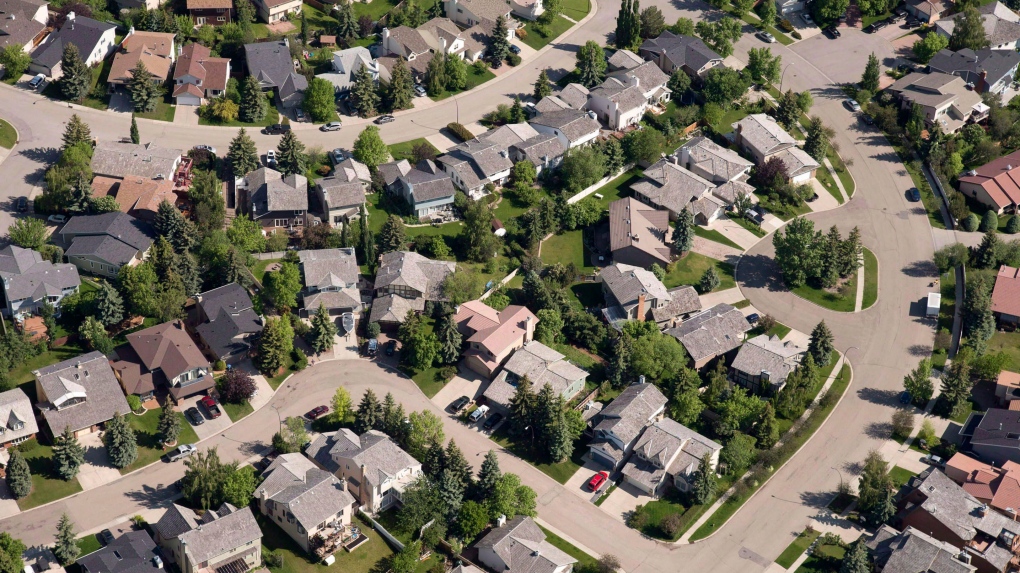Economic conditions improving in Alberta, mortgage report suggests
 An aerial view of housing in Calgary is shown on June 22, 2013. THE CANADIAN PRESS/Jonathan Hayward
An aerial view of housing in Calgary is shown on June 22, 2013. THE CANADIAN PRESS/Jonathan Hayward
The number of homeowners who are behind on their mortgage payments has reached one of the lowest levels since the beginning of the pandemic, new statistics indicate.
On Wednesday, the Canadian Bankers Association released its latest report on the number of mortgages in arrears – situations where payments haven't been made in three or more months.
Out of the 5,104,550 mortgages in Canada, just 7,426 (0.15 per cent) are in arrears, it said.
When it comes to Alberta, the association found that while the province had almost 30 per cent of Canada's arrears total, the percentage of homeowners who have fallen behind is continuing to drop.
The latest report shows 2,176 of Alberta's 605,353 mortgages, which the association says includes those in N.W.T. and Nunavut, are in arrears.
The figure is just 0.36 per cent of the total – the lowest it's been since 2008.
"Canada's oil-producing provinces were hit hard by the pandemic and therefore faced more difficult economic conditions as they recovered, in part due to the cyclical nature of their economies," said Mathieu Labrèche, director of media strategy and communications with the Canada Bankers Association in a statement.
He says favourable economic conditions are returning, which is relieving pressure on many residents.
"As unemployment figures in Alberta have started to return to their pre-pandemic levels, the province is seeing a corresponding drop in arrears rates. The mortgages in arrears rate in Alberta is well below one per cent."
The highest rate of mortgage arrears is seen in Saskatchewan at 0.61 per cent, but it has been steadily decreasing since the beginning of 2019.
CTVNews.ca Top Stories

Ministers Joly, LeBlanc travel to Florida to meet with Trump's team
Two members of Prime Minister Justin Trudeau's cabinet will be in Palm Beach, Fla., Friday to meet with members of Donald Trump's team.
India alleges widespread trafficking of international students through Canada to U.S.
Indian law enforcement agencies say they are investigating alleged links between dozens of colleges in Canada and two 'entities' in Mumbai accused of illegally ferrying students across the Canada-United States border.
Teen actor Hudson Meek, who appeared in 'Baby Driver,' dies after falling from moving vehicle
Hudson Meek, the 16-year-old actor who appeared in 'Baby Driver,' died last week after falling from a moving vehicle in Vestavia Hills, Alabama, according to CNN affiliate WVTM.
Pizza deliverer in Florida charged with stabbing pregnant woman at motel after tip dispute
A pizza deliverer in central Florida has been charged with pushing her way into a motel room with an accomplice and stabbing a pregnant woman after a dispute over a tip, authorities said.
Unwanted gift card in your stocking? Don't let it go to waste
Gift cards can be a quick and easy present for those who don't know what to buy and offer the recipient a chance to pick out something nice for themselves, but sometimes they can still miss the mark.
Cat food that caused bird-flu death of Oregon pet was distributed in B.C.: officials
Pet food contaminated with bird flu – which killed a house cat in Oregon – was distributed and sold in British Columbia, according to officials south of the border.
Aviation experts say Russia's air defence fire likely caused Azerbaijan plane crash as nation mourns
Aviation experts said Thursday that Russian air defence fire was likely responsible for the Azerbaijani plane crash the day before that killed 38 people and left all 29 survivors injured.
Police identify victim of Christmas Day homicide in Hintonburg, charge suspect
The Ottawa Police Service says the victim who had been killed on Christmas Day in Hintonburg has been identified.
Raised in Sask. after his family fled Hungary, this man spent decades spying on communists for the RCMP
As a Communist Party member in Calgary in the early 1940s, Frank Hadesbeck performed clerical work at the party office, printed leaflets and sold books.































